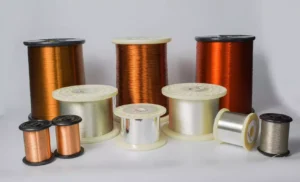A stuffy warehouse makes workers sweat and slows production. You need cool air fast to keep machines and people safe.
Fans move large volumes of air at low pressure, creating a gentle breeze. Blowers push air at moderate pressure to a specific spot, making a focused wind stream.
Keep reading to see how each device works and when to pick a fan or a blower.
How a Fan Works
A hot day in a factory brings sweat and slow work. A fan starts spinning to solve the heat and speed up air flow.
A fan turns electrical energy into air flow with low pressure rise. Its blades spin to draw air in and push it out axially.

Step 1: Power On and Motor Spin
When you flip the switch, electricity flows to the motor. The motor changes electrical power into rotation.
Step 2: Blade Rotation
The motor shaft connects to the impeller or rotor. Blades on the impeller start to spin.
Step 3: Air Intake
As blades spin, they lower pressure at the fan inlet. This draws air from the room or duct.
Step 4: Axial Discharge
The air moves along the blade axis. It leaves the fan in a straight path, creating a steady breeze.
Fans create little pressure gain, often under 1.11 times inlet pressure. They only need to beat small losses in blade and housing parts. A home ceiling fan fits this model. It moves a lot of air without a big push.
Fans work in open spaces or light ducts. They use less power and run quietly. You see them in room coolers, computer cases, and shop vents. Their low pressure rise makes them cost‑effective and simple to install.
Types of Fans
A warehouse needs airflow in many spots. You pick a fan based on space, resistance, and noise level.
Axial fans push air straight through, while centrifugal fans throw air out sideways. Mixed‑flow and crossflow fans blend those flows. Bladeless fans use hidden blades for quiet, smooth air.

| Fan Type | Flow Direction | Pressure Rise | Common Use |
|---|---|---|---|
| Axial | Straight | Low | Ceiling, box, computer fans |
| Centrifugal | Sideways | Moderate | HVAC, blowers, dryers |
| Mixed‑Flow | Both | Moderate | HVAC, paint booths |
| Crossflow | Tunnel-like | Low | Car vents, radiators |
| Bladeless | Amplified ring | Low | Tower fans, purifiers |
Axial Fans
These are propeller style. Blades spin around a central hub. They move a lot of air in straight lines.
Centrifugal Fans
Blades sit on a wheel. Air enters at the center and exits at right angles. They work in ducts and can handle more resistance.
Mixed‑Flow Fans
Blades are angled. They push air forward and outwards. They balance flow rate and pressure.
Crossflow Fans
Air passes through a long drum of blades. It forms a smooth curtain of air.
Bladeless Fans
A hidden impeller draws air in. It blows out through a ring to boost speed.
Fan choice depends on space, noise, and resistance. Axial fans excel in free air. Centrifugal ones rule in ducts. Mixed‑flow offers mid‑range performance. Crossflow works in tight spaces. Bladeless scores on design and safety.
How a Blower Works
A dusty vented room needs targeted air. A blower fires up to clear dust or push air through pipes.
A blower spins an impeller in a housing. It raises pressure moderately, then sends a focused stream of air out a nozzle or duct.

Step 1: Drive the Impeller
Electric power spins the impeller shaft. The impeller sits inside a scroll or casing.
Step 2: Air Inlet
Air enters the impeller eye at center. The blades catch and accelerate it.
Step 3: Centrifugal Action
As blades spin, centrifugal force pushes air outward. This builds pressure inside the casing.
Step 4: Directed Outlet
The pressurized air exits through an outlet or nozzle. The casing directs the stream to a set point.
Blowers boost pressure up to about 1.2 times inlet pressure. They beat higher system losses than fans. You find blowers in furnaces, hair dryers, and dust‑collection systems.
Types of Blowers
A factory line needs a strong jet for cleaning parts. You pick a blower based on flow, pressure, and duty cycle.
Centrifugal blowers use curved impeller blades in a scroll. Rotary lobe blowers trap air with meshing lobes. Regenerative blowers spin air in a side channel. Axial flow blowers mimic fans but at higher pressure.

| Blower Type | Pressure Rise | Flow Pattern | Common Use |
|---|---|---|---|
| Centrifugal | Moderate‑high | Radial outlet | HVAC, dust collection |
| Rotary Lobe | Constant pressure | Pulsating flow | Wastewater, pneumatic pipes |
| Regenerative | Moderate | Vortex build‑up | Vacuum, air knives |
| Axial Flow | Moderate | Straight outlet | Cooling towers, fans |
Centrifugal Blowers
An impeller spins in a housing. Air enters center and leaves at 90°. The scroll guides the flow.
Rotary Lobe Blowers
Two lobed rotors mesh without touching. They trap air pockets and push them out.
Regenerative Blowers
Air spirals between impeller blades and housing. It gains energy with each pass.
Axial Flow Blowers
They look like axial fans. The blades and motor are sized for higher pressure tasks.
Blower design impacts noise, efficiency, and footprint. Centrifugal blowers work at high speed. Rotary types deliver steady flow at low speed. Regenerative ones run quietly but have lower flow. Axial flow blowers suit large volumes under moderate pressure.
Conclusion
Fans move air gently; blowers push air firmly. Choose a fan for broad, low‑pressure flow and a blower for focused, higher‑pressure needs.
FAQs
What is the main difference between a fan and a blower?
A fan moves large air volumes at low pressure for broad cooling. A blower generates a focused, moderate‑pressure stream for targeted ventilation or cleaning.
Can I use a blower instead of a fan for room cooling?
You can, but blowers use more power and make noise. Fans are more efficient for general room cooling and low‑resistance airflow.
Do blowers consume more energy than fans?
Yes. Blowers raise air pressure more, so they need stronger motors. Fans draw less power for the same size.
Which is quieter: a fan or a blower?
Fans usually run at lower speed and larger blades. They make less noise. Blowers use high pressure and speed, so they can be louder.
How do I choose between a fan and a blower?
Look at system resistance, airflow needs, and noise limits. Choose a fan for low resistance and broad flow. Pick a blower for duct work or targeted air.
Are axial and centrifugal blowers the same?
No. Axial blowers push air straight, like fans but at higher pressure. Centrifugal blowers throw air sideways from a scroll housing.
Why use a blower for a dust collector?
Dust collectors need to move air through filters and pipes. Blowers provide the required pressure rise to overcome those resistances.
What industries rely more on blowers than fans?
Wastewater treatment, pneumatic conveying, and industrial drying use blowers for consistent, moderate‑pressure air streams.






